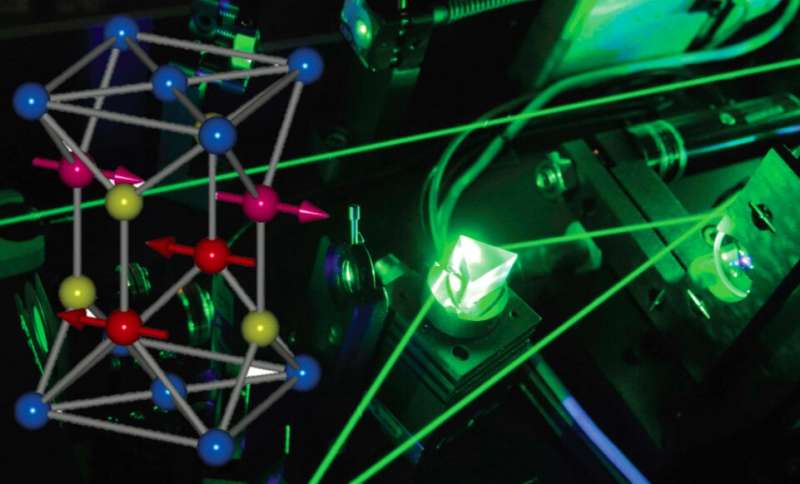January 6, 2021 feature
Study demonstrates the quenching of an antiferromagnet into high resistivity states

Antiferromagnetism is a type of magnetism in which parallel but opposing spins occur spontaneously within a material. Antiferromagnets, materials that exhibit antiferromagnetism, have advantageous characteristics that make them particularly promising for fabricating spintronic devices.
In contrast with conventional electronic devices, which use the electrical charge of electrons to encode information, spintronics process information leveraging the intrinsic angular momentum of electrons, a property known as "spin." Due to their ultrafast nature, their insensitivity to external magnetic fields and their lack of magnetic stray fields, antiferromagnets could be particularly desirable for the development of spintronic devices.
Despite their advantages and their ability to store information, most simple antiferromagnets have weak readout magnetoresistivity signals. Moreover, so far physicists have been unable to change the magnetic order of antiferromagnets using optical techniques, which could ultimately allow device engineers to exploit these materials' ultrafast nature.
Researchers at the Czech Academy of Sciences, Charles University in Prague and other universities in Europe recently introduced a method to achieve the quenching of antiferromagnets into high resistivity states by applying either electrical or ultrashort optical pulses. This strategy, introduced in a paper published in Nature Electronics, could open interesting new possibilities for the development of spintronic devices based on antiferromagnets.
"Our original motivation was to address a major challenge in the field of spintronics, for which the solution seems out of reach of conventionally used ferromagnets; namely, the lack of a universal switching mechanism to achieve switching by electrical as well as optical pulses in the same device," Tomas Jungwirth, one of the researchers who carried out the study, told Phys.org. "Our antiferromagnetic devices allow for this, and we can now use pulse length from macroscopic millisecond scales all the way down to a single femtosecond-laser pulse."
In their recent study, Jungwirth and his colleagues were able to overcome a further challenge in the field of spintronics. Specifically, they were able to attain readout signals of the giant-magnetoresistance amplitudes in simple magnetic films, without the need to assemble complex magnetic multilayer structures. The researchers achieved this using CuMnAs antiferromagnetic films.
Remarkably, they were able to fabricate spintronic devices with reversible, reproducible and time-dependent switching capabilities. This ability to switch magnets allows their devices to mimic components of spiking neural networks (SNNs), artificial neural networks that mimic biological neural networks in the brain. This feature of the design introduced by Jungwirth and his colleagues has never been realized using conventional methods that switch magnets by reorienting the magnetization vector from one to another direction over the entire active part of devices.
"Our switching mechanism is fundamentally distinct: The delivered quenching pulses control the level of magnetic domain fragmentation in the device down to a nano-scale, without necessarily changing the mean direction of the magnetic-order vector," Jungwirth explained. "Remarkably to us, this can be done in an entirely reversible and reproducible way, as we demonstrated in the paper."
In the future, the new design introduced by Jungwirth and his colleagues could enable the development of new and better performing spintronic devices. In their next studies, the researchers plan to investigate the potential of their design for neuromorphic computing applications. In other words, they plan to explore the possibility of using the devices they created to mimic some of the synaptic and neuron-like functionalities of SNNs.
"On a scientific level, we now aim to investigate and explain the physical fundamentals of our new switching mechanism by means of high space and time-resolved microscopies pushed to the atomic and femtosecond limits," Jungwirth said. "This will help us to optimize the parameters of currently used antiferromagnetic materials or identify new suitable material candidates."
More information: Quenching of an antiferromagnet into high resistivity states using electrical or ultrashort optical pulses. Nature Electronics(2020). DOI: 10.1038/s41928-020-00506-4
Journal information: Nature Electronics
© 2021 Science X Network





















